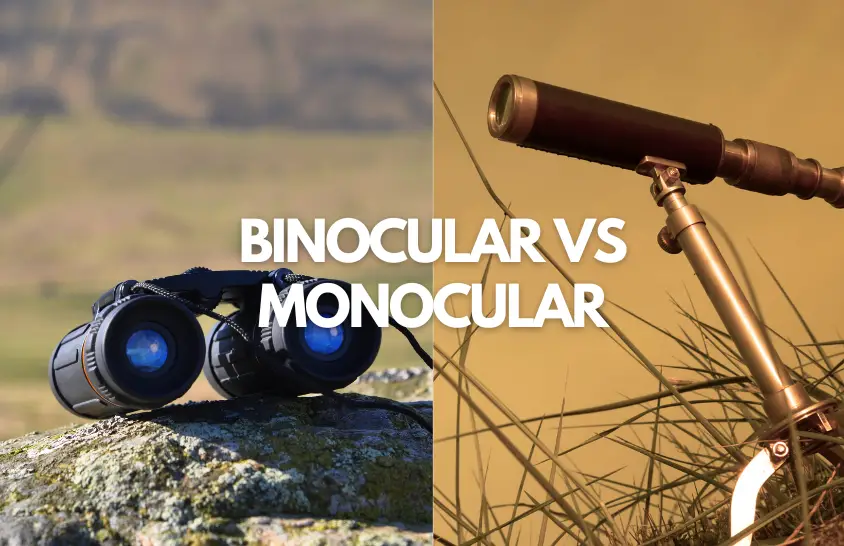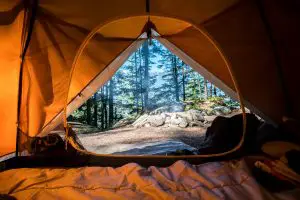Monoculars vs. Binoculars For Hiking: Which Is Better?

When it comes to getting a great view on the trails, having the right equipment is essential. One important tool (or tools) to consider is binoculars or a monocular — but which one is better? Let’s take a closer look at the differences between the two to help you decide which one is best for your next hiking adventure.
Binoculars have two barrels that are connected together and allow you to see in three-dimensional vision. These are great for spotting far away objects and capturing nature’s beauty, making them ideal for activities like bird watching and sightseeing. On the other hand, a monocular is a single-barrel telescope that typically has a higher magnification and a wider field of view than binoculars. This makes them perfect for activities like hunting and stargazing, as they offer way more precise detail and allow you to see more clearly in low-light conditions.
So, depending on your needs, either a binocular or a monocular can truly be the perfect choice for your next hiking adventure. Let’s explore further to learn more about the benefits of each, so you can decide which one is right for you.
Quick Links
What are the Advantages and Disadvantages of Monoculars and Binoculars for Hiking?
When it comes to the advantages of monoculars and binoculars, each one offers something different, depending on the type of hiking you plan to do.
Monoculars are great because they provide a better and clearer view than binoculars, especially when looking at distant objects or in low-light conditions. They are much lighter and more compact than binoculars, making them easier to carry around.
Monoculars also provide more versatility and range, as they can usually be used for both far away and close-up viewing.
On the other hand, binoculars have the advantage of giving you a three-dimensional view, making them ideal for birdwatching or sightseeing. They are also great for taking in sweeping panoramas of landscapes, and the two barrels provide an even better level of detail than monoculars. However, binoculars tend to be bigger and heavier, which can make them harder to transport, and they don’t typically have the same level of zoom or range as monoculars.
How do Monoculars and Binoculars Impact Visual Perception for Hiking?
When it comes to visual perception while hiking, both monoculars and binoculars can have a major impact, depending on the situation.
For example, monoculars can provide a greater depth of field than binoculars, meaning that you can focus on specific objects or areas more accurately. This can be especially useful for recognizing landmarks or spotting wildlife in the distance. And don’t forget, as far as visual perception goes – you’re gonna need to get used to keeping your other eye shut. Monoculars can lead to a bit of eye strain if you aren’t too familiar with using one.
Binoculars, on the other hand, may be better suited for getting a better overall view of a larger area. They can provide a wider field of view and allow you to observe more detail in a single glance. This makes them a great choice for taking in the entire landscape and identifying distant objects more easily. In conclusion, the choice between monoculars and binoculars for hiking really comes down to personal preference and the type of activity you plan to do.
What are the Key Features to Look for in Monoculars and Binoculars for Hiking?
No matter which one you choose, it’s important to know what features to look for when shopping for monoculars and binoculars for hiking. Here are a few key features to consider:
- Magnification: This is the most important feature to look for when choosing monoculars or binoculars. It determines how much closer the object will appear and how much detail can be seen. It’s typically expressed as a number (ex: 8x or 5x) and should match the activity you plan to do.
- Field of View: This is the width of the area you can see at any given time and is usually measured in feet. Generally, the wider the field of view, the better.
- Eye Relief: This is the distance between your eye and the eyepiece of the monocular or binoculars. It’s most important for those who wear glasses, as the closer the eye relief, the less eye strain the user will experience.
- Weight: The weight of your monoculars or binoculars plays an important role in how comfortable they are to use. The lighter the ocular, the easier it will be to carry while hiking.
- Durability: Monoculars and binoculars can take a beating! So, durability is an especially important factor to consider when choosing a monocular or binocular for hiking. Most monoculars and binoculars are made of plastic and glass, but some also feature rubber armor to protect them from scratches and drops. Some models also come with waterproof and fog-proof coatings to ensure they can withstand the elements.
- Optical Coatings: Coatings on the lenses of monoculars and binoculars help reduce glare, improve clarity, and increase the amount of light that passes through them. Look for coatings like multi-coated optics, phase correction, and dielectric coatings to ensure you get the best image possible.
- Size: The size of the monocular or binoculars you choose can make a big difference in how comfortable they are to use. Generally, the larger the lens, the brighter and sharper the image will be. However, larger lenses can also be more difficult to hold and carry for long periods of time.
- Price: Last but not least, both monoculars and binoculars come in a wide range of prices, so you’ll want to consider your budget when shopping. However, it’s important to remember that you often get what you pay for when it comes to optics. Off-topic, but I recently splurged on a nice macro lens for close-up photography, and it’s been awesome. If you’re curious, check out my article on how to hike with a DSLR.
What Is Better For Stargazing – Binocular Or Monocular?
When it comes to stargazing, binoculars are usually the best choice. Binoculars provide a wider field of view than monoculars, making it easier to take in the beauty of the night sky. They also provide greater magnification, allowing you to take in more detail, and they can offer more comfortable viewing for those with eye problems.
However, if you’re looking for a lightweight and easy-to-carry option for stargazing, a monocular can still work! As I mentioned, monoculars are smaller, lighter and more versatile than binoculars, making them great for stargazing on-the-go. They also provide some of the same magnification as binoculars, so you can still take in the stars in great detail.
But If you REALLY want to take your stargazing to the next level, consider investing in a telescope. Telescopes provide much greater magnification, allowing you to observe planets, moons, nebulae, and galaxies. Telescopes are AWESOME in dark-sky places. Check out the official list of dark sky parks here.
Conclusion
Whether you decide to purchase a monocular, binocular, or even a telescope, it’s important to note that the quality of your viewing experience will largely depend on the quality of your optics. You’ll want to look for optics that are made from high-quality materials and offer durable construction. That way, you can be sure that your optics will last for a long time.
It’s also important to consider the type of optics that are best suited for your situation. If you need something lightweight and portable, then a monocular is probably the better choice. On the other hand, if you want to take in more detail, then a binocular or telescope would be better. Either way, you’ll want to do your research to make sure you choose the right optics for your needs.
No matter which type of optics you choose, being able to take in the scenery in much greater detail is an unbelievable experience and one that you WILL NOT regret!







